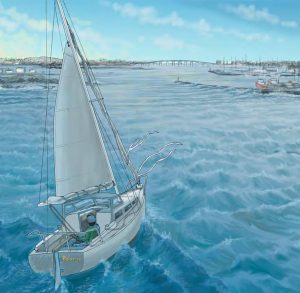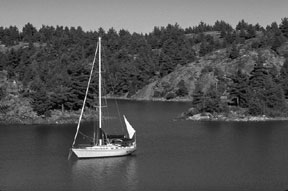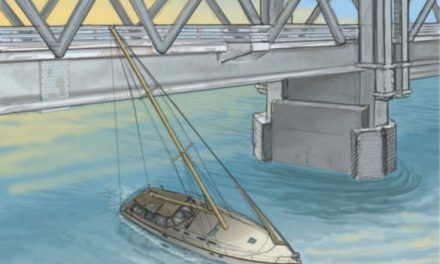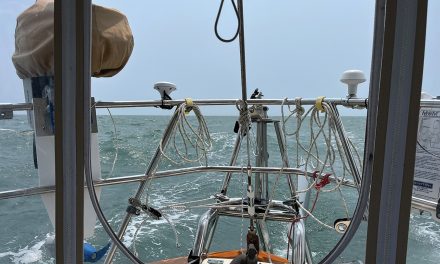A sailor flouts an age-old superstition and pays the price
Issue 150: May/June 2023
After what seemed like a short, mild winter, I was ready to splash for the summer season. The boatyard didn’t launch boats on weekends, and the earlier part of the week featured nearly gale-force wind, so the weather forecast made it seem like Friday, April 1, was the best day for it.
I didn’t have too far to go. From the winter boatyard in New Bern to my summertime slip at Northwest Creek Marina was less than 5 miles, but it was circuitous; parts of the channel through the North Carolina swamp could easily be used for a remake of The African Queen. All was ready on the boat and I was good to go.
 The Travelift picked up Pelorus, my good old (1980) 26-foot Paceship, and got it into the water with no difficulty. The depth indicator at the yard showed almost 6 feet of water, which would ordinarily be enough for her 4-foot 5-inch draft. The engine started perfectly. I cast off the lines and made it almost as far as the entry to the enclosed marina, when I Talesran aground on what turned out to be a new shoal, mostly mud.
The Travelift picked up Pelorus, my good old (1980) 26-foot Paceship, and got it into the water with no difficulty. The depth indicator at the yard showed almost 6 feet of water, which would ordinarily be enough for her 4-foot 5-inch draft. The engine started perfectly. I cast off the lines and made it almost as far as the entry to the enclosed marina, when I Talesran aground on what turned out to be a new shoal, mostly mud.
Right, I thought. April Fool’s Day. I get it. The Clerk of the Weather was having his little joke. Fortunately, I was able to get into a transient slip without further ado. When I talked with the yard manager, she said that when the wind blows hard as it had been doing from the southwest, it tended to blow the water out of some of the back creeks, like the one at this landlocked marina in the vast inland sea behind the Outer Banks, where the usual tide is at best a matter of inches; and yes, the shoal was new and thanks for finding it.
A few days later, after the wind fell light and shifted more into the north, the water level came back to usual and I was able to get to my summer slip with no problem, except that partway through the swamp the engine died. Someone I could name but won’t had turned the fuel shutoff valve at the tank into the off position for winter storage. After a moment of panic, I opened the valve and the engine ran fine, no bleeding required.
 That same week, there was a boat show and maritime flea market scheduled for Saturday in Oriental, North Carolina, about 25 miles away. I’d always enjoyed anchoring in what is called “the sailing capital of North Carolina” and decided to leave the day before, on Friday, to spend the next day at the event, returning on Sunday.
That same week, there was a boat show and maritime flea market scheduled for Saturday in Oriental, North Carolina, about 25 miles away. I’d always enjoyed anchoring in what is called “the sailing capital of North Carolina” and decided to leave the day before, on Friday, to spend the next day at the event, returning on Sunday.
The forecast was for wind out of the southwest again, 15 to 20 knots with higher gusts possible — sporty but manageable, I thought. All I had to do was beat to windward on a starboard tack for about 10 or 12 miles, then turn to port to get around Wilkinson Point, the southernmost part of the peninsula that has New Bern on the northwest and Oriental midway up the east side of it, like Cape Horn in miniature. At that point the wind, if it held, would be over the transom. As I left the marina, the water was sparkling, the sun was shining, and the sky was blue, although temperatures were on the cool side, with upper 40s forecast for that night. What a good day for sailing!
All was well with two reefs in the main and my old workhorse 110% genoa until I was about 2 miles shy of Wilkinson Point. The boat was behaving wonderfully in the nasty, short chop that built up on those shallow waters, and although there was lots of spray, the dodger was keeping it off me. I was admiring the rainbow in the spray to leeward when I heard over the gusting wind a ripping sound and saw that the genoa had torn from a point midway along the foot to a point halfway up the leech and was only held together by tape along the foot and leech.
Oddly, the boat was still making way to windward, only slower, and through the gap in the two parts, a rainbow shone as I dropped what was left of the genny onto the foredeck. However, under double-reefed main with no headsail and the port shrouds festooned with shreds of torn sail, there was no headway to be made at all. I could always turn around and go back — tempting, but I was bound and determined.
 Although it seemed like cheating, I started the engine and motorsailed the short distance around Wilkinson Point until I could turn downwind and shut the engine off. Even with two reefs in the main, downwind I could make better than 4 knots under sail, and the next 10 or 12 miles were a treat.
Although it seemed like cheating, I started the engine and motorsailed the short distance around Wilkinson Point until I could turn downwind and shut the engine off. Even with two reefs in the main, downwind I could make better than 4 knots under sail, and the next 10 or 12 miles were a treat.
After I dropped the hook in the vest pocket anchorage behind the breakwater at Oriental, I took stock. It did seem hard that the genny failed on the first real sail of the season, but it was roughly 15 or 18 years old and owed me nothing. So far over the time I’d owned my boat, I’d blown out the main twice and now the headsails twice. One more and I’m an ace!
In this kind of wind, I could make do with the storm jib, something about half the size of the foretriangle, which I bought 20 years ago and used exactly once, and which had been resting comfortably in the bilge these many years in who knows what condition. I hauled it out, and after I oiled the hanks, it seemed likely to be able to get me home, especially as the wind was forecast to back into the southeast over the next few days, again at 15 to 20 knots.
That night, thinking it over, I remembered the old sailor’s superstition: Never start a voyage on a Friday. There are other superstitions said to bring bad luck — whistling brings a gale, never sail with a preacher or with women aboard, among other things. I’m not superstitious. Whistling? Really? Women sailors are commonplace these days and I know of a boat in Newport, Rhode Island, called On Retreat, said to be owned by a minister. When parishioners call, his answering machine says he’s “on retreat.”
True, I had sailed one afternoon with a friend who happened to be a minister; yes, he was seasick over the side and spewed heroically to leeward, afterward laying on deck apparently dead, only to be miraculously resurrected when we picked up the mooring. Nevertheless, I had started two voyages back to back on Fridays a week apart, something I had never done before, and now look what happened. Talk about luck, sheesh!
On Saturday, I went looking for a replacement sail among the nautical gear on sale at the flea market. There were several sails that would have worked, though they were small. I had better luck at the only store in town that sold boating supplies and was very near the dinghy dock; here I found a replacement genny 2 feet shorter in the luff and maybe 6 inches longer on the foot, perhaps 12 or 15 square feet smaller overall. Close enough, and it only cost $100. On the other hand, it needed work; the luff tape was torn and there were two hanks missing.
The next day there was a little less wind, so I sailed back to my slip at Northwest Creek with the storm jib and a single reef in the main. When I got the new genny home, I was able to replace the torn luff tape and hand-sew on the two missing hanks, salvaged from one of my old sails.
And best of all, when I got back to the boat to try it out, it fit perfectly well with a 12-inch wire strop at the tack, and I didn’t have to move the sheet blocks. What luck!
Good Old Boat Contributing Editor Cliff Moore sails Pelorus, an AMF Paceship 26 he acquired and rebuilt after Hurricane Bob trashed it in 1991. His first boat was a Kool Cigarettes foam dinghy with no rudder or sail.
Thank you to Sailrite Enterprises, Inc., for providing free access to back issues of Good Old Boat through intellectual property rights. Sailrite.com





